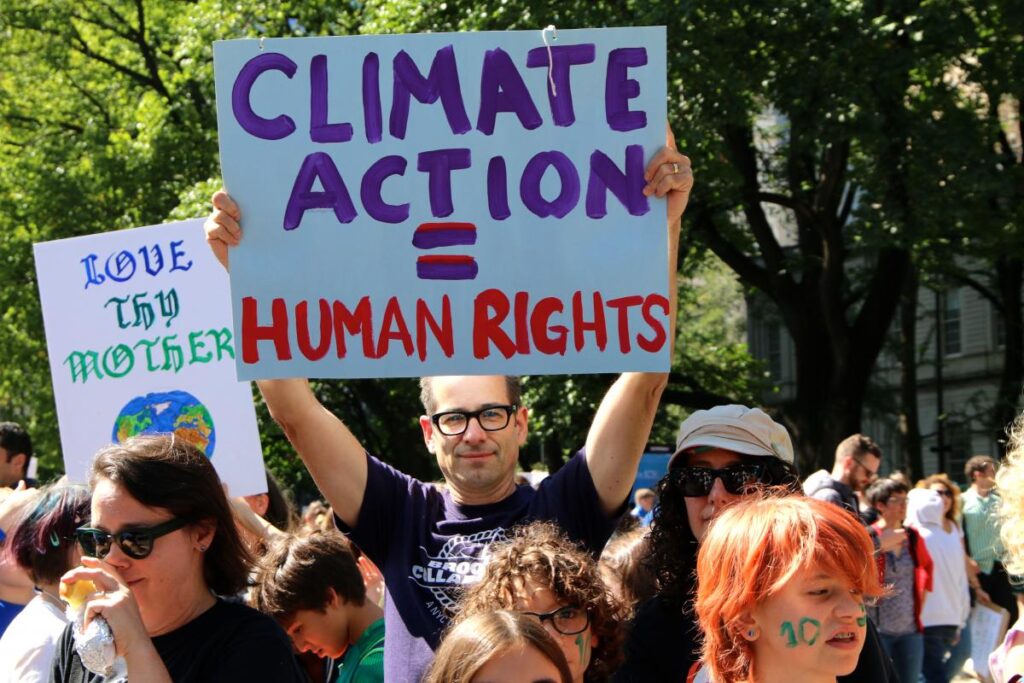Naveen Talawar
“There will be no human rights when the world we live in is scorched, sunken and toxic.”
Chiara Liguori, Researcher and Advisor on Climate Justice
Introduction
Everything that supports life, including water, air, and soil, is part of the environment. The environment has an impact on human growth and development. We cannot progress unless the environment is safe and secure. A healthy environment is essential for everyone. Since the environment contains all life, the right to a clean environment is an all-encompassing right required for other rights to be realised. According to the consequences of climate change, e future of all living things is in danger when the environment is damaged. As a result, recognising and protecting the right to a clean environment necessitates considerable effort. Any environmental damage has a significant impact on its beneficiaries, including humans.
This article examines the right to a clean and healthy environment and the United Nations Human Rights Council’s recent adoption of a resolution on the human right to a clean, healthy, and sustainable environment (HRC).
Human Right to a Clean and Healthy Environment
Human rights and the environment are inextricably linked: a safe, clean, healthy, and sustainable environment is required to exercise our human rights, whereas polluted, hazardous, or otherwise unhealthy environments potentially infringe on our human rights.
A clean, healthy and sustainable environment is widely regarded as being necessary for many long-standing and universally recognised human rights, such as the right to life, the right to the best physical and mental health possible, the right to an adequate standard of living, the right to enough food, the right to housing, the right to clean water and sanitary conditions, and the right to participate in cultural activities. These and other human rights can be difficult to exercise when environmental harm or degradation occurs. Despite this global consensus regarding the close connection between human rights and a healthy environment, there is no universal agreement on the exact legal status of the environment in the context of international human rights discourse.
The concept of a human right to the environment was first introduced into international law at the United Nations Conference on the Human Environment in 1972, sparking debate about the human right to a clean and healthy environment. The World Commission on Environment and Development also suggested that environmental rights be recognised as human rights.
Justice Weeramantry of the International Court of Justice acknowledged the connection between environmental protection and human rights in his separate ruling in the case involving the Gabcikovo-Nagymaros Project. He also incorporated ecological protection into the framework of human rights. He observed,
“Environmental preservation is… an important aspect of modern human rights philosophy because it is a precondition for many human rights, including the right to health and the right to life itself.” It is hardly necessary to go into detail here because environmental degradation may jeopardize and weaken all of the human rights enshrined in the Universal Declaration and other human rights treaties.”
International Recognition of a Clean and Healthy Environment
Environmental concerns were first brought to the forefront of global concerns at the Stockholm United Nations Conference on the Environment in 1972, which resulted in a historic declaration. It also marked the beginning of a dialogue between industrialised and developing nations on the connection between economic growth, pollution of the air, water, and oceans, and the well-being of people everywhere.
At the time, the UN Member States urged for immediate action and the recognition of this right, stating that people have a fundamental right to “an environment of sufficient quality to allow a life of dignity and well-being.“
Similar to this, the Rio Declaration of the United Nations Conference on Environment and Development (UNCED) highlights the right of humans to a healthy and productive life in harmony with nature. Later, the American Convention on Human Rights 1998 Protocol of San Salvador affirms that everyone has the right to “live in a healthy environment” in Latin America. The right to live in dignity in a sustainable global environment is also guaranteed by the Hague Declaration on the Environment of 1989. Additionally, it promotes the preservation of the world economy and calls for increased UN authority to safeguard the environment.
Nearly 20 years after the Stockholm Conference, the United Nations General Assembly reiterated the language of the Stockholm Declaration in Resolution 45/94, noting that it recognises everyone has a right to live in a space suitable for their health and well-being.
International recognition of the right to a healthy environment is much more limited, as states have been reluctant to adopt a binding legal instrument recognising such a right. As a result, the right to a healthy environment has little legal significance under international environmental law. In response to this opposition, in addition to the aforementioned initiatives, there have been additional attempts to include the right to a healthy environment in international treaties. The first Article of the draft Global Pact for the Environment (2017) recognised the right to a healthy environment.
Human Rights Council’s Resolution 48/13
The UN Human Rights Council adopted a resolution on October 8, 2021, recognising the right to a clean, healthy, and sustainable environment as a human right. This decision is a significant step forward. Although it is not legally binding, its near-unanimous approval demonstrates agreement on the concept, content, and significance of this fundamental right. The resolution was overwhelmingly supported, with 161 votes in favour and eight against; the UN General Assembly approved a landmark resolution designating access to a clean, healthy, and sustainable environment as a basic human right.
The first Article of the Resolution affirms “the right to a clean, healthy, and sustainable environment as a human right that is essential for the enjoyment of human rights.”
António Guterres, the UN Secretary-General, commended the historic decision and said it demonstrated Member States’ ability to cooperate in the fight against the triple global catastrophe of pollution, biodiversity loss, and climate change. He said
“The resolution will help to reduce environmental injustices and protection gaps. It can empower people, especially those in vulnerable situations, including environmental human rights defenders, children, youth, women and indigenous people”.
The declaration clarifies nearly all of the rights related to environmental health. The UN High Commissioner for Human Rights, Michelle Bachelet, stated that “everyone, everywhere, has the right to eat, breathe, and drink without poisoning their bodies.“
According to David Boyd, UN Special Rapporteur on Human Rights and the Environment, “This right is not mentioned in the 1948 Universal Declaration of Human Rights. This historic resolution will change the overall structure of international human rights legislation. The right to a healthy environment reflects a fundamental fact that should bring people together in a culture that all too frequently emphasises individual differences.“
Consequences of such Recognition
The right to a healthy environment poses procedural as well as substantive legal issues. A majority of States have passed legislation articulating the procedural and substantive conditions for effective implementation of the right to a healthy environment, with national jurisdictions serving as models.
On the one hand, recognising a right to a healthy environment frequently entails defending procedural rights, including the right to information, the ability to participate in environmental decision-making, and access to the legal system. In addition to procedural rights, the right to a healthy environment also has a substantive component. The right to a healthy environment, in whatever form it takes, protects the natural environment characteristics that allow for a reasonable standard of living.
National recognition of the right to a healthy environment should result in the passage of implementation laws. However, states that recognise this right in their Constitutions or through regional treaties do not always put it into law. The right to a healthy environment cannot be completely realised until it is effectively integrated into national laws and practices. Many states still fail to meet their commitments to fully respect, defend, and realise the right to a healthy environment.
Role of the Indian judiciary in Upholding the Right to a Clean and Healthy Environment
One of the core principles of sustainable development is the universal right of all living beings to a healthy environment and well-being. The Indian judiciary has successfully expanded the fundamental right to personal liberty guaranteed by Article 21 of the Indian Constitution.
In Ratlam Municipal Council v. Shri Vardichand & Others, the Supreme Court acknowledged in a significant case that came before it under Section 133 of the CrPC that the right to a clean and healthy environment is a basic right under Article 21.
The Supreme Court of India interpreted Article 21 of the Indian Constitution to include the right to live in a pollution-free environment as a part of the fundamental right to life in M C Mehta v. Union of India. Additionally, the A. P. The High Court decided that Article 21 of the Constitution includes the right to live in a healthy environment in T. Damodar Rao v. S. O. Municipal Corporation, Hyderabad.
The right to a clean environment is a fundamental right. The High Court of Andhra Pradesh explicitly cited Article 21 in its ruling in T. Ramakrishna Rao v. Hyderabad Urban Development, noting that “the slow poisoning of the atmosphere caused by the environmental pollution and spoliation should be regarded as amounting to a violation of Article 21 of the Constitution.” Thus, the Indian Supreme Court and other lower courts have expanded the scope of fundamental rights to include environmental safeguards and effectively supported the right to a clean and healthy environment.
Conclusion
Everyone requires a healthy atmosphere. It has a variety of effects on our lives. As a result, it is our responsibility to protect the environment, which is also a vital demand. The judiciary in India is claimed to have been the first to exhibit greater concern and adequate attention to environmental protection from various pollinations. Reviewing the thought-provoking decisions of many High Courts and the Supreme Court makes clear the judiciary’s crucial contribution to the advancement of new environmental protection aims. It took the lead in the development of environmental law through its activist attitude.
In addition, the Human Rights Council resolution is a major first step with the potential for broad effects on both the environment and human rights. This resolution could inspire even greater international recognition and perhaps even the drafting of an international convention on the right to a healthy environment if brought before the General Assembly.
References
Views are personal.

